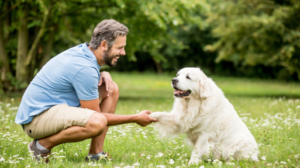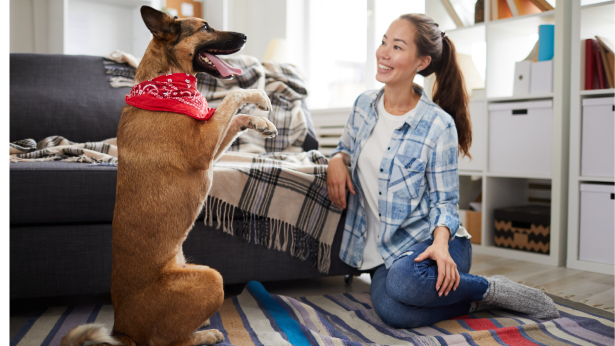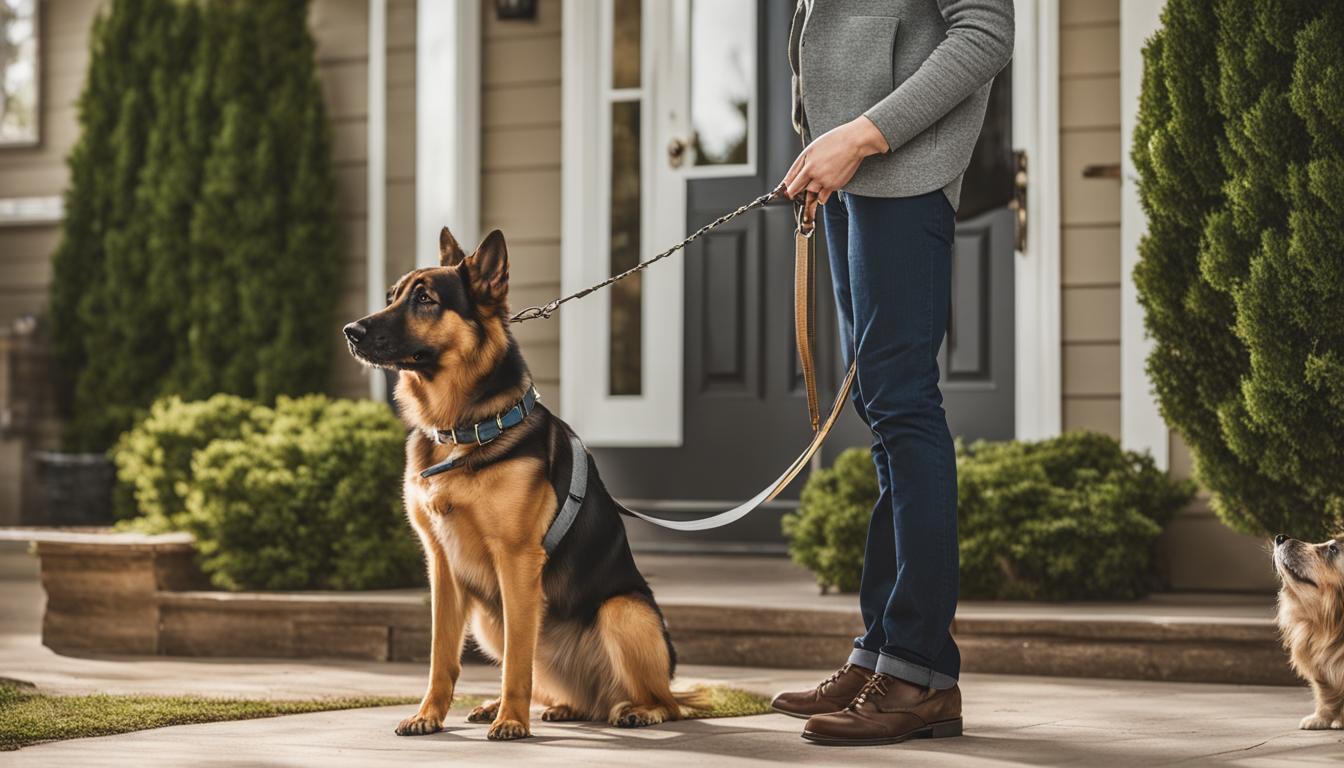Alpha dog behavior has long been a topic of discussion in the dog training world. Traditional training methods focused on dominance and force-based techniques, based on the concept of alpha dogs and pack mentality. However, positive reinforcement training, which uses rewards and encourages desired behaviors, has gained popularity as a more humane approach in Correcting Alpha Dog Behavior.
While the terms alpha and pack leader are often seen as controversial, it is important to recognize the importance of leadership and structure in a dog’s life. Balancing fairness, respect, and positive methods can lead to a well-behaved and harmonious household.
The concept of the “alpha dog” has become prevalent in recent years, leading many owners to mistakenly label their dogs as dominant or assertive. However, the alpha dog hierarchy is a common misconception – while dogs are social animals that may challenge each other, the idea of a rigid dominance hierarchy is inaccurate.
This article will explain the origins of the alpha dog concept, reasons for alpha behaviors, and most importantly, positive training strategies to correct unwanted behaviors and build a healthy relationship between owner and dog. With proper techniques focused on clear communication, consistency, and empathy, the human can assume the leadership role and gain a well-behaved canine companion.
Key Takeaways:
- Correcting alpha dog behavior requires a balanced approach.
- Positive reinforcement training is a more humane and effective method.
- Leadership and structure are crucial for a harmonious household.
- Fairness, respect, and positive methods foster a well-behaved dog.
- Building a strong bond with your pet is essential.
Understanding the Alpha Dog Concept and Behavior
The notion of alpha dogs originated from 1940s studies on wolf packs by animal behaviorist Rudolph Schenkel. His research proposed that wolf packs organize themselves into a hierarchy with dominant alpha wolves leading subordinate followers. Later researchers applied his wolf theories to domesticated dogs in the 1970s, suggesting that dogs also adhered to a strict social hierarchy.
This concept influenced many dog training approaches – that owners must dominate their dog to become the alpha. However, this understanding of wolf and dog behavior has since been disproven. Wolves in the wild actually live in family units rather than alpha-dominated groups. And domesticated dogs, though still social animals, do not seek the same strict hierarchy.
Research has shown that dogs thrive in environments where they have a clear leader to provide direction and establish boundaries. This is particularly important during early training sessions and when addressing behavioral issues. By assuming the role of the pack leader, you can help your dog feel more secure and confident, which in turn leads to better behavior overall.
It’s important to note that being a pack leader does not mean resorting to dominance or force-based techniques. In fact, studies have found that positive reinforcement training methods, which focus on rewards and encouragement, are more effective and humane. By using positive reinforcement, you can motivate your dog to exhibit desired behaviors, strengthening your bond and fostering a harmonious relationship based on trust and mutual respect.
| Alpha Dog Behavior | Pack Mentality |
|---|---|
| Alpha dogs are considered the leaders of the pack, responsible for establishing rules and maintaining order. | Pack mentality refers to the social structure and dynamics within a group of animals, such as a pack of wolves or a household of dogs. |
| Being a pack leader involves taking on responsibilities such as protection, provision, teaching, and leading. | A pack leader provides guidance and enforces rules to maintain harmony and order within the pack. |
| While the terms alpha and pack leader may be controversial, the need for structure and guidance in a dog’s life remains essential. | Establishing yourself as a pack leader can help your dog feel more secure and confident, leading to better behavior overall. |
Misconceptions About Alpha Dog Behavior
Despite newer research, the myth persists that dogs are constantly vying for dominance. Many misread normal canine behavior as a dog’s attempt at becoming alpha over the owner. For example, pulling on leash, jumping on furniture, or walking ahead could all be misconstrued as dominating acts but often simply reflect excitement or lack of training.
Even aggressive behaviors like resource guarding are not necessarily signs of attempting alpha status. They frequently stem from fear or anxiety around specific triggers. The key is accurately identifying the motivations behind a dog’s actions rather than making assumptions.
Importance of Understanding Canine Hierarchy
While extreme alpha dominance theories have been debunked, dogs are still social pack animals. Understanding their social structure and instincts can help owners better communicate.
Dogs look to leaders for guidance and boundaries. Providing this clear direction helps mitigate undesirable behaviors. Rather than engaging in a battle of dominance, owners should build trust and assume a benevolent leadership role.
Identifying Alpha Dog Behavior
Before correcting behaviors, it is important to properly identify them. Many perceived alpha behaviors are simply signs of other issues. True dominating behaviors exhibited by dogs include:
- Guarding food, toys or sleeping areas
- Growling if moved off furniture or away from people
- Posturing like stiffening, staring, erect posture
- Mounting people, dogs or objects
- Raising hackles when approached
- Blocking doors or passages
Distinguishing between Alpha Behavior and Behavioral Issues
Sometimes alpha-like behaviors are actually fearful or anxious reactions to specific triggers. Fearfulness, reactivity and aggression should be treated differently than expressions of dominance. It is crucial to discern the motivation, whether through a trainer or comprehensive vet exam.
The Impact of Mislabeling a Dog as Alpha
Attempting to dominate dogs incorrectly perceived as alphas can worsen behavior issues. Harsh discipline or intimidation tactics will erode the dog’s trust. The dog may react defensively, and the anxious or aggressive responses get rewarded, reinforcing the behavior. Accurate identification allows proper training tailored to the real issue.
Professional Assessment
If struggling to diagnose alpha motivations versus other behavioral drivers, seek help from accredited professionals. Certified applied animal behaviorists, veterinary behaviorists, and some certified dog trainers can provide tailored treatment plans.
Understanding the Root of Alpha Dog Behavior
Alpha behaviors generally develop for several key reasons:
Lack of Proper Socialization
Dogs who missed out on early positive exposure to new places, people and animals are more likely to be reactive and guard resources. Proper socialization builds confidence.
Inconsistent Training and Boundaries
Without clear rules and structure, dogs don’t know what’s expected of them. Inconsistency and leniency encourages pushy behaviors.
Anxiety and Environmental Factors
Changes in routine, lack of exercise, or stressful environments can elicit behaviors like guarding valued items, which provides comfort.
Owner Behavior and Reinforcement
Owners may inadvertently reward alpha behaviors by giving affection when dogs posture or mount. Leaving food near aggressive dogs also reinforces guarding.
Training Strategies to Correct Alpha Dog Behavior
The goal of training is not domination, but building respect and trust to help dogs happily follow rules and look to owners for guidance. Recommended approaches include:
Leadership without Dominance
Provide a consistent daily routine with opportunities for exercise, enrichment and bonding. Set boundaries without intimidation tactics. Earn respect through clear communication, praise and rewards.
Consistent Rules and Boundaries
Practice NILIF (nothing in life is free) expectations like requiring a sit before feeding, doors opening or receiving toys. Dogs learn to work for rewards and respect boundaries.
Redirecting and Managing Dominant Behaviors
If a dog guards resources, use treats to counter-condition them to surrender items or allow handling. Reward tolerating interactions. Manage the environment by separating dogs during food time.
Behavioral Modification Techniques
Use techniques like desensitization, counter-conditioning and positive reinforcement to change emotional responses to triggers. For example, reward calm behavior, not anxious barking at passersby.
Positive Reinforcement
Motivate dogs using rewards-based training and avoid physical discipline or punishment, which harms trust. Praise and treat desired behaviors.
Ignoring Undesired Behaviors
Avoid rewarding bad behavior with attention. Refrain from consoling anxious dogs. Simply ignore, redirect or give time-outs for inappropriate actions. Eventually the dog learns these behaviors do not get results.
Time-out Strategies
Briefly isolate dogs engaging in unacceptable dominance behaviors to discourage the conduct. Time-outs should occur immediately and without anger.
Stress Reduction Techniques
Lessen anxiety by providing plenty of exercise, mental stimulation and outlets for natural instincts like chewing. A tired, enriched dog is less prone to acting out.
The Role of the Owner in Correcting Behavior
Humans play a pivotal role in eliciting, preventing and correcting alpha dog conduct. Owners should:
- Provide consistent rules and training
- Avoid reinforcement of bad behaviors
- Project calm assertive energy, not anger/anxiety
- Commit to lifelong training and management
- Know when to seek professional help
Proper handling by owners can bring out the best in dogs.
Common Challenges and Solutions
Correcting alpha conduct takes time and diligence. Common hurdles include:
| Challenge | Solution |
|---|---|
| Dog regresses into problem behaviors | Re-commit to training consistently. Seek professional help adjusting techniques as needed. |
| Aggression escalates during training | Stop training immediately. Avoid physical punishment.Consult a vet and trainer. Consider medication if necessary. |
| New behaviors develop | Some dogs will test boundaries in other ways when denied. Remain vigilant and redirect promptly. Expand training. |
| Balancing multiple dogs | Give individual attention. Separate dogs in crates/rooms for feeding. Walk and train separately. |
| Change in environment or owner | Stick to routine as much as possible. Slowly acclimate dog to differences. Be patient during transitions. |
Prevention of Alpha Dog Behavior
Preventing alpha conduct from ever developing includes:
- Early and ongoing socialization
- Choosing breeds/temperaments compatible with environment/lifestyle
- Researching and understanding dog psychology
- Avoiding physical punishment or intimidation
- Committing to lifelong positive training techniques
Proper care, leadership and training allows dogs to feel secure, not needing displays of dominance.

The Importance of Positive Reinforcement Training
Positive reinforcement training is a highly effective method for shaping behavior in dogs. This approach focuses on using rewards, such as treats or praise, to encourage desired behaviors and create a strong bond between the dog and the owner. By avoiding the use of force, threats, or intimidation, positive reinforcement training promotes a force-free and harmonious training experience.
The key principle of positive reinforcement training is to control access to resources and encourage self-interest. By rewarding the dog for displaying the desired behavior, we reinforce that behavior and increase the likelihood of it being repeated. For example, when teaching a dog to sit, we reward them with a treat each time they successfully sit on command. Over time, the dog learns that sitting leads to a positive outcome and becomes more likely to comply with the command.
This approach fosters mutual respect and harmony between the dog and the owner. It focuses on building a trusting relationship based on clear communication, understanding, and respect. Dogs respond well to positive reinforcement training because it allows them to make choices and engage in behaviors that are naturally rewarding to them. By shaping behavior through positive reinforcement, we can effectively train our dogs without causing fear or anxiety.
Benefits of Positive Reinforcement Training:
- Creates a positive and enjoyable training experience for both the dog and the owner.
- Builds a strong bond and trust between the dog and the owner.
- Encourages dogs to make the right choices based on their own motivation.
- Reduces the risk of fear, anxiety, and aggression in dogs.
- Promotes polite manners, obedience, and good behavior.
In conclusion, positive reinforcement training is a powerful tool for shaping behavior in dogs. It focuses on rewarding desired behaviors and creating a trusting and harmonious relationship between the dog and the owner. By using this force-free training method, we can guide our dogs to make the right choices and develop polite manners, obedience, and good behavior.
Debunking Alpha Dog Myths
When it comes to alpha dog behavior, there are numerous myths and misconceptions that can lead to ineffective training methods and misunderstandings between dog owners and their furry companions. It’s important to separate fact from fiction and debunk these myths to create a harmonious and respectful relationship with your dog.
Myth: Alpha roll corrects alpha behavior
One common myth is the belief that forcing a dog onto their back, known as the alpha roll, can correct alpha behavior. This technique is based on the outdated concept of dominance and can actually lead to fear, aggression, and a breakdown of trust between you and your dog. It’s important to prioritize positive reinforcement and reward-based training methods instead.
Myth: Dominance is the root of all behavior issues
Another myth surrounding alpha dog behavior is the idea that dominance is the root cause of all behavior issues. While dominance does play a role in a dog’s behavior, it is not the sole factor. Other factors such as fear, anxiety, lack of socialization, and medical conditions can also contribute to behavioral problems. It’s important to address the underlying causes rather than focusing solely on dominance.
“Forcing a dog onto their back, known as the alpha roll, can actually lead to fear, aggression, and a breakdown of trust between you and your dog.”
Myth: Staring contests establish dominance
Many dog owners believe that engaging in staring contests with their dog helps establish dominance. However, this practice can be stressful for your dog and may lead to feelings of intimidation or aggression. Instead, focus on positive training methods that encourage desired behaviors and reinforce the bond between you and your dog.
Myth: Punishment is an effective training tool
Using punishment as a training tool is not only ineffective but can also be harmful to your dog’s well-being. Physical punishment or harsh reprimands can lead to fear, anxiety, and even aggression. Positive reinforcement training, on the other hand, focuses on rewarding desired behaviors and shaping your dog’s behavior in a gentle and humane way.
By debunking these alpha dog myths, you can approach dog training with a more informed and compassionate mindset. Emphasizing positive reinforcement, understanding individual factors contributing to behavior issues, and maintaining open communication with your dog will lead to a healthier and happier relationship for both of you.
| Myth | Fact |
|---|---|
| Alpha roll corrects alpha behavior | Forcing a dog onto their back can lead to fear, aggression, and a breakdown of trust |
| Dominance is the root of all behavior issues | Dominance is one factor among others, including fear, anxiety, socialization, and medical conditions |
| Staring contests establish dominance | Staring contests can cause stress and feelings of intimidation; focus on positive training methods instead |
| Punishment is an effective training tool | Punishment can be harmful and ineffective; positive reinforcement is a more humane and successful approach |

Establishing Yourself as a Consistent Leader
Becoming a leader in the dog-human relationship is crucial for creating a harmonious household. To establish yourself as a consistent leader, it’s important to focus on routines and consistency, clear communication, and assertiveness. By implementing these practices, you can build a strong bond with your dog based on trust and respect.
Routines and consistency provide structure and predictability in your dog’s life, which can help them feel secure and confident. Set a regular schedule for feeding, exercise, and training sessions. Consistently enforce house rules and boundaries. Dogs thrive in an environment where they know what to expect, and this establishes you as a reliable leader.
Clear communication is another key aspect of being a leader. Use positive reinforcement techniques to reward your dog’s good behavior and redirect them when they make mistakes. Give them clear signals and cues to understand what you expect from them. Use verbal praise, physical touch, and treats effectively to reinforce desired behaviors.
Assertiveness is essential in establishing yourself as a leader. It means being firm and confident without resorting to aggression. Walk with confidence, maintain eye contact, and use a calm and assertive tone of voice. When setting and enforcing rules, be consistent and fair. Your dog will trust and respect you when they see you as a confident and capable leader.
| Benefits of Establishing Yourself as a Leader | How to Establish Yourself as a Leader |
|---|---|
|
|
The Importance of Consistency
Consistency is key when establishing yourself as a leader. Dogs thrive on routine and predictability. Make sure to follow the same rules and guidelines every day. If you allow certain behaviors one day and not the next, your dog may become confused and develop inconsistent behavior. Consistency provides clarity and helps your dog understand what is expected of them.
When it comes to training, consistency is essential. Use the same commands, hand signals, and rewards consistently to reinforce desired behaviors. This helps your dog understand what you want from them and facilitates their learning process. Consistency also helps build trust between you and your dog, as they learn to rely on your guidance and consistency.
Overall, establishing yourself as a consistent leader sets the foundation for a positive and balanced dog-human relationship. By implementing routines and consistency, clear communication, and assertiveness, you can create a harmonious household and enjoy a well-behaved, happy dog.
The Role of Rewards and Positive Reinforcement
When it comes to training your dog, rewards and positive reinforcement play a crucial role in shaping behavior and promoting good manners. By using rewards such as treats, praise, or playtime, you can reinforce desired behaviors and encourage your dog to continue displaying them. Whether you’re working on basic obedience commands or teaching your dog to have polite manners, positive reinforcement techniques can be highly effective.
Positive reinforcement training focuses on rewarding your dog for performing the desired behavior, rather than punishing them for mistakes or unwanted actions. This approach creates a positive association with obedience, making the learning process enjoyable for your pet. It not only strengthens the bond between you and your dog but also builds their confidence and trust in you as their leader.
One effective way to incorporate positive reinforcement is through the use of a reward-based training system. This involves offering a reward, such as a small treat or verbal praise, immediately after your dog successfully performs the desired behavior. Over time, your dog will associate the behavior with a positive outcome and be more likely to repeat it in the future. Consistency and timing are key in reward-based training, as your dog needs to make the connection between their actions and the reward they receive.
“Reward-based training not only helps your dog develop good behavior, but it also creates a harmonious and enjoyable relationship between you and your pet.” – Dog Training Expert
In addition to treats and praise, other rewards such as playtime with a favorite toy or access to a special activity can also be used to reinforce positive behaviors. It’s essential to tailor the rewards to your dog’s preferences and use them consistently throughout the training process. By doing so, you can harness the power of positive reinforcement to teach your dog obedience, good manners, and create a well-behaved companion.
| Benefits of Rewards and Positive Reinforcement in Dog Training |
|---|
| Rewards create a positive association with desired behaviors, making the training process enjoyable for your dog. |
| Positive reinforcement strengthens the bond between you and your dog, fostering a harmonious relationship. |
| Using rewards helps build your dog’s confidence and trust in you as their leader. |
| Consistent use of rewards reinforces good behavior and encourages your dog to repeat it. |
| Varying types of rewards, such as treats, praise, or playtime, cater to your dog’s preferences and maintain their interest. |
Conclusion
In summary, the outdated concept of alpha dog hierarchies causing behavioral issues has been debunked by modern behavioral science. To correct alpha dog behavior and create a harmonious household, embracing positive training methods and providing clear leadership and structure is essential. By focusing on positive reinforcement, consistency, and communication, you can promote a trusting and respectful relationship with your dog. This approach, which avoids dominance displays, helps curb undesirable conduct and allows both you and your pet to thrive in a mutually beneficial partnership.
FAQ
What is alpha dog behavior?
Alpha dog behavior refers to the concept that every pack, including domesticated dogs, requires a leader or alpha to establish rules and maintain harmony within the group.
What is positive reinforcement training?
Positive reinforcement training is an approach that uses rewards, such as treats or praise, to encourage desired behaviors in dogs. It promotes mutual respect and avoids the use of force, threats, or intimidation.
Are alpha rolls effective in correcting alpha behavior?
No, alpha rolls, which involve forcing a dog onto their back, are not effective and can lead to fear, aggression, and a breakdown of trust.
Do I need to always eat before my dog or go through doorways first?
No, these beliefs are based on outdated and disproven theories. There is no scientific evidence to support the idea that you must always eat before your dog or go through doorways first.
How can I establish myself as a leader in the dog-human relationship?
Establishing yourself as a leader involves maintaining routines, consistency, and clear communication. Walking with confidence, maintaining eye contact, and setting and enforcing rules can help establish your role as a leader.
How can rewards and positive reinforcement help in training my dog?
Rewards and positive reinforcement are essential in training your dog. By rewarding desired behaviors with treats, praise, or playtime, you reinforce those behaviors and encourage your dog to repeat them, teaching polite manners and good behavior.
What is the balanced approach to correcting alpha dog behavior?
Correcting alpha dog behavior requires a balanced approach that combines positive reinforcement training, clear communication, and consistent leadership. It’s about creating a harmonious relationship based on trust and mutual understanding.
Source Links
- https://chasingdogtales.com/alpha-dogs-and-pack-mentality-revisited/
- https://foreverhusky.org/2022/02/02/secrets-to-becoming-the-alpha-dog-be-your-dogs-pack-leader/
- https://www.whole-dog-journal.com/behavior/alpha-dog-myths/
References
- O’Heare, Jamie. Canine Aggression Workbook. DogPsych Publishing, 2021.
- Burch, Mary R., and Jon S. Bailey. How Dogs Learn. Howell Book House/Wiley Publishing, 1999.
- Horowitz, Alexandra. Domestic Dog Cognition and Behavior. Springer, 2014.
- Zink, Christina, and Suzanne clothier. How to Behave so Your Dog Behaves. Dogwise Publishing, 2017.
- AVMA. “Dog Bite Prevention.” American Veterinary Medical Association, www.avma.org/resources/dog-owners/dog-bite-prevention.
Recommended Reading and Resources
- Humane Society International: www.hsi.org/news-media/resource-library/
- ASPCA: www.aspca.org/pet-care/dog-care
- APDT: www.apdt.com/public/ts-tips/






